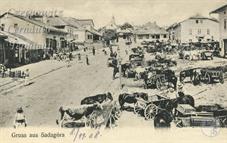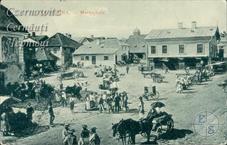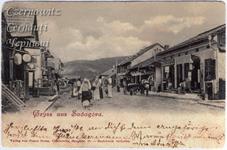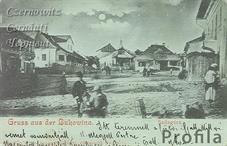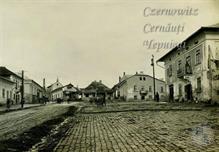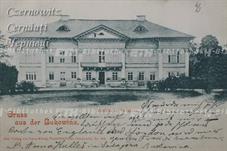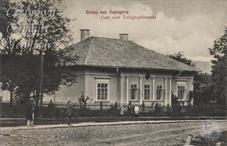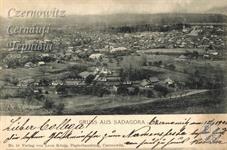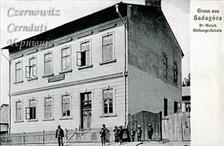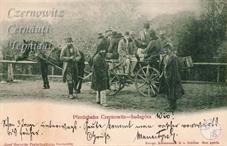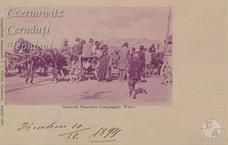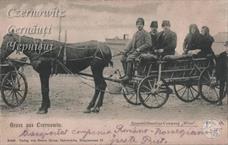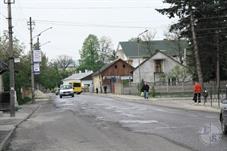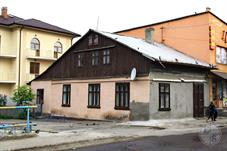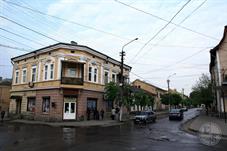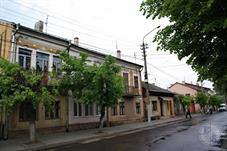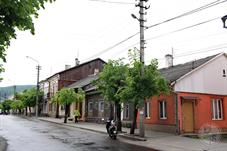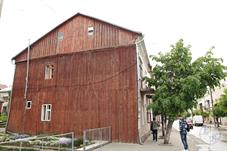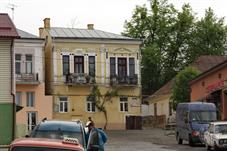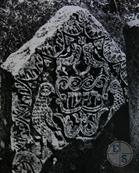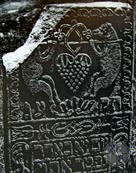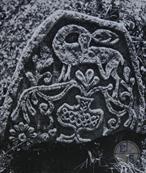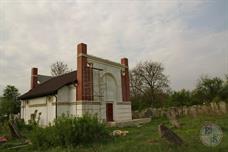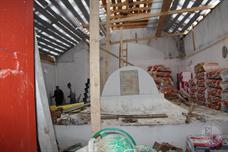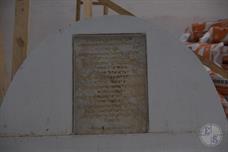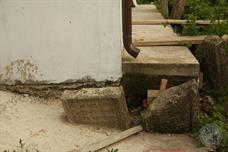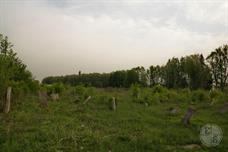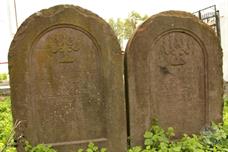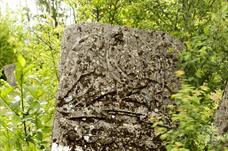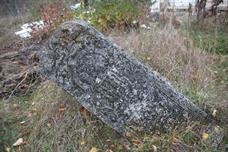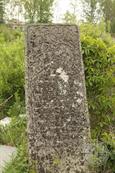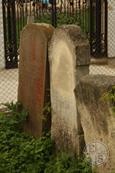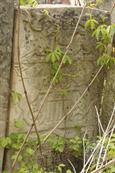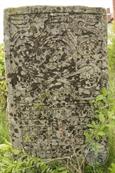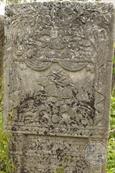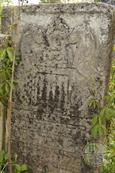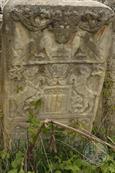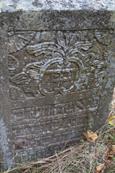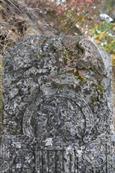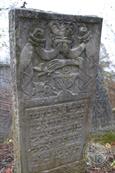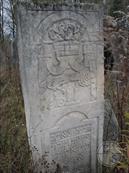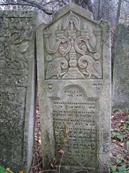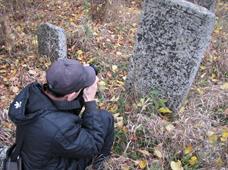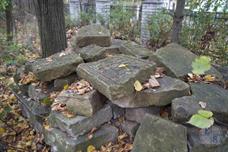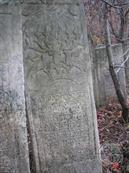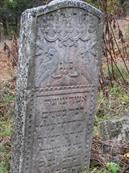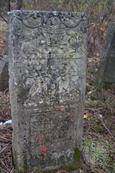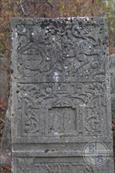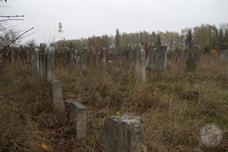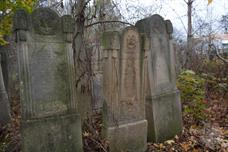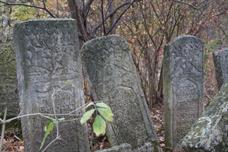Sadgora
Sadgora, 2014, 2016
The town of Sadagura (now Sadgora - district of city Chernivtsi) was founded in 1770 by Baron Peter von Hartenberg.
To the Jewish cultural center of Sadagura there belonged another 16 communities in which Jews lived. These represented the provinces for which Sadagura was the seat, and also the Austrian policies by which the smaller communities of indigenous Jews were, as far as religion was concerned, under a greater cultural organization. The names of the 16 communities were Rohozna, Neu-Zuczka, Alt-Zuczka, Cameral-Lenkoutz, Privat-Lenkoutz, Bila, Buda, Unter-Szeroutz, Ober-Szeroutz, Szubranetz, Zadobrowka, Waschkoutz, Czernawka, Rarancze, Toporoutz, and Dobronoutz. The Jews of all these communities proudly considered themselves belonging to the Sadagura Jews, to their Kultusgemeinde [community leadership], their city rabbi, and their wonder rabbi of the Ruzhiner dynasty.
At last, after "120 years," Sadagura was the only Jewish burial site for the communities, a place made sacred by the graves of the Ruzhiner wonder rabbis, a famous maggid (wandering preacher), and the Sadaguran city rabbis of the Landau family. Here was also the seat of the Zionist union, the Talmud-Torah and Yeshiva schools.
In Sadagura stood the famous over 200-year old great synagogue, and the weekly market and annual fair were also held there. The communities around Sadagura of Rohozna (Baranowka), Neu-Zuczka, and Unter-Szeroutz (Slobodka), formed a single complex; the borders were erased over time. The Kultuspresidents of the community were not only Sadagura Jews; sometimes this honor was also bestowed on Jews from the surrounding areas, as for example the prize-winning animal breeder, Josef Fischer, tenant of the 3,000 hectares surrounding the property of the Greek-Oriental religious center in Toporoutz, owner of the only glass factory in the region in Kloster-Putna.
"Greater Sadagura" was also the seat of the only ritual and steam bath, and the slaughterhouse also served the Jews of the entire area. In the last years before the First World War, the market town alone counted 10,000 Jews, and with the remaining 16 communities 13,000 Jews.
To the Jewish cultural center of Sadagura there belonged another 16 communities in which Jews lived. These represented the provinces for which Sadagura was the seat, and also the Austrian policies by which the smaller communities of indigenous Jews were, as far as religion was concerned, under a greater cultural organization. The names of the 16 communities were Rohozna, Neu-Zuczka, Alt-Zuczka, Cameral-Lenkoutz, Privat-Lenkoutz, Bila, Buda, Unter-Szeroutz, Ober-Szeroutz, Szubranetz, Zadobrowka, Waschkoutz, Czernawka, Rarancze, Toporoutz, and Dobronoutz. The Jews of all these communities proudly considered themselves belonging to the Sadagura Jews, to their Kultusgemeinde [community leadership], their city rabbi, and their wonder rabbi of the Ruzhiner dynasty.
At last, after "120 years," Sadagura was the only Jewish burial site for the communities, a place made sacred by the graves of the Ruzhiner wonder rabbis, a famous maggid (wandering preacher), and the Sadaguran city rabbis of the Landau family. Here was also the seat of the Zionist union, the Talmud-Torah and Yeshiva schools.
In Sadagura stood the famous over 200-year old great synagogue, and the weekly market and annual fair were also held there. The communities around Sadagura of Rohozna (Baranowka), Neu-Zuczka, and Unter-Szeroutz (Slobodka), formed a single complex; the borders were erased over time. The Kultuspresidents of the community were not only Sadagura Jews; sometimes this honor was also bestowed on Jews from the surrounding areas, as for example the prize-winning animal breeder, Josef Fischer, tenant of the 3,000 hectares surrounding the property of the Greek-Oriental religious center in Toporoutz, owner of the only glass factory in the region in Kloster-Putna.
"Greater Sadagura" was also the seat of the only ritual and steam bath, and the slaughterhouse also served the Jews of the entire area. In the last years before the First World War, the market town alone counted 10,000 Jews, and with the remaining 16 communities 13,000 Jews.
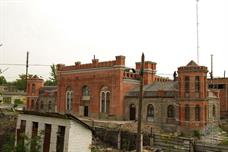 |
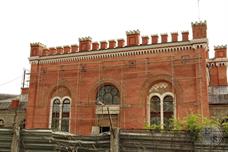 |
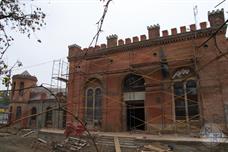 |
 |
| Synagogue of the Ruzhin tzadik | |||
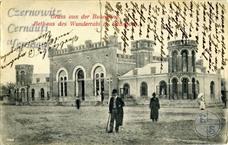 |
 |
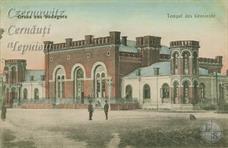 |
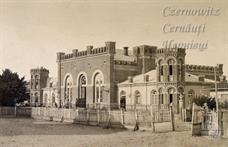 |
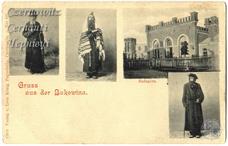 |
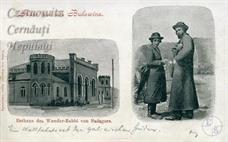 |
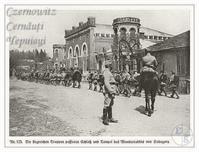 |
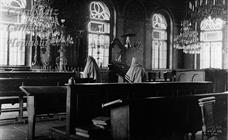 |
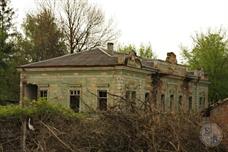 |
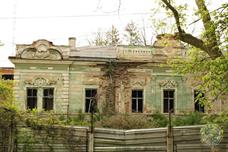 |
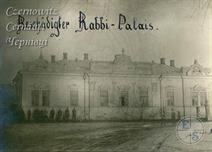 |
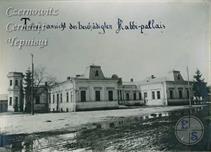 |
| But with the palace the situation is worse | It is almost completely destroyed | So the palace looked originally | |
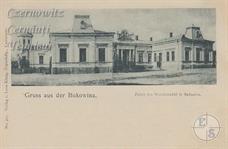 |
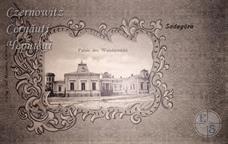 |
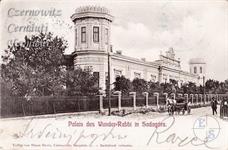 |
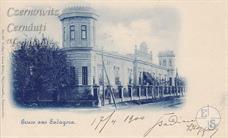 |
Chernivtsi region
The Jews of the town were mainly craftsmen and merchants. There were also many among them whose working life was not stable, such as day laborers, street vendors, wagon drivers, and especially water carriers. The latter were the poorest of the poor, who brought two cans of water, in frost and snow, to the kitchen of their customer, to receive only a kreuzer or two heller (the smallest coins), and who were dependent on the kind-hearted, compassionate housewives who now and then gave them a morsel. The troughs out of which the water would be dipped were sometimes quite far from the homes of the customers, and the work of the water carriers, whose worn clothing and footwear provided no protection against the cold, was a great hardship, especially in icy conditions. In the country communities, the Jews were street vendors and bar tenders to a lesser extent; mostly they practiced farming and animal husbandry and achieved a comfortable living through hard work. The non-Jewish landowners could follow their example. Well-known were the families Kula in Rarancze, Rittberg and Süsser in Toporoutz, Horowitz and Winkler in Dobronoutz, the families Polesiuk in Czernawka, the bee-keeper Lohner in Toporoutz, as well as the family Blum in Rohozna.
There were also many Jewish tenant farmers and part-owners who practiced agriculture, such as the families Greif, Runes, Fischbach, Rubel, Grauer and Lande. The Jewish craftsmen (shoemakers, tinsmiths, tailors, woodworkers, carpenters, butchers, bakers, barbers, metalworkers, and furriers) held their vocations in high regard and were organized into guilds. Because of their expertise, they usually became the guild masters for the guilds that were made up of Jews and non-Jews, as for example, Leiser David Isser, Mechel Fischer, Breitner, Burghäuser, Danziger, Poppel, Feldmann, Reisch and Vogel. The great number of wagon drivers who handled the passenger and freight traffic between Sadagura and Czernowitz should not be overlooked. They ruled over large freight wagons and smaller one-horse carts (known as "chap-dich-auf-wägelech" ) as well as carriages.
There were also many Jewish tenant farmers and part-owners who practiced agriculture, such as the families Greif, Runes, Fischbach, Rubel, Grauer and Lande. The Jewish craftsmen (shoemakers, tinsmiths, tailors, woodworkers, carpenters, butchers, bakers, barbers, metalworkers, and furriers) held their vocations in high regard and were organized into guilds. Because of their expertise, they usually became the guild masters for the guilds that were made up of Jews and non-Jews, as for example, Leiser David Isser, Mechel Fischer, Breitner, Burghäuser, Danziger, Poppel, Feldmann, Reisch and Vogel. The great number of wagon drivers who handled the passenger and freight traffic between Sadagura and Czernowitz should not be overlooked. They ruled over large freight wagons and smaller one-horse carts (known as "chap-dich-auf-wägelech" ) as well as carriages.
There was also a silent guild of Jewish teachers for the religious matters. The little children and also the public school children enjoyed the instruction of the so-called "dardik-melamdim", "Gemara-melamdim," and the Talmud-teacher. These teachers suffered bitter privations, especially as the salary per child and semester amounted to only 5-6 guilders, which before 1914 was worth about $3. One such religious school, known as cheder , was attended by an average of 25-30 boys and girls. From a meager income, the teacher had to support his sometimes large family. He was usually undernourished, and his family members were often tubercular. A single room served equally as living, sleeping, eating, and school room. In winter, to protect against the cold, the windows were sealed with mud and thus could never be opened.
Usually the sons of the teacher inherited the profession and the business of the father, and were already apprentices ( "belfer" ) during his lifetime. The Scherzer family provided many of the representatives of the guild of the dardik-melamdim.
Each of the guilds in Sadagura had their own prayer house; many guilds, such as the tailors and freight wagon owners, even had 2-3 prayer houses. Sadagura was divided into several districts which consisted of one or more small streets. There was a street for the barbers and bath owners; in the so-called "Swine Street," one found in virtually every house that the workplace and the residence were one and the same. Those of the barbers were designated outside by a round, shiny brass circle (symbol of the soap bowl), which was affixed to a wooden signpost. At the barbers, the farmers allowed themselves to be shaved or to have their hair cut short for only 1-2 kreuzers (i.e., 1/2-1 US cent). The barbers were active now and then as quacks and sold leeches, too. In the "Synagogue Street" were located the ritual, steam, and tub baths, and the old age home and hospital, the so-called "heckdesh." This street rightly bore the name, "Synagogue Street," because that is where 11 prayer houses and the great synagogue stood. In these prayer houses, the Sadagurans gathered three times a day in order to perform their devotions. The names of the prayer houses reflected the activity and the spiritual leaning of those attending. There was a "Gemilath Chessed" (credit union without interest) group, a tailor group, a shoemaker group, a melamdim Ruzhiner group (after the rabbinical family of Sadagura), a Kossower group (after the city of Kossow in east Galicia), a middle group (so-called because this prayer house stood in the middle of all the prayer houses), a beth hamidrash group. The "Sacrament Schül" was the prayer house for early risers and heavy laborers; in this synagogue, the morning prayers began already at first light. The worshippers in this "Sacrament Schül" were known as "permitted Israelites"; in jest, they were called "bilkefresser," as they had the reputation of an ulterior motive for attending the prayer house early in the morning (especially on the Sabbath), because this way they could partake of their meal at the very earliest time. Then there were the devout worshippers, primarily craftsmen, wagon drivers, and porters, who wouldn’t eat a morsel without first having said the prescribed prayers.
Usually the sons of the teacher inherited the profession and the business of the father, and were already apprentices ( "belfer" ) during his lifetime. The Scherzer family provided many of the representatives of the guild of the dardik-melamdim.
Each of the guilds in Sadagura had their own prayer house; many guilds, such as the tailors and freight wagon owners, even had 2-3 prayer houses. Sadagura was divided into several districts which consisted of one or more small streets. There was a street for the barbers and bath owners; in the so-called "Swine Street," one found in virtually every house that the workplace and the residence were one and the same. Those of the barbers were designated outside by a round, shiny brass circle (symbol of the soap bowl), which was affixed to a wooden signpost. At the barbers, the farmers allowed themselves to be shaved or to have their hair cut short for only 1-2 kreuzers (i.e., 1/2-1 US cent). The barbers were active now and then as quacks and sold leeches, too. In the "Synagogue Street" were located the ritual, steam, and tub baths, and the old age home and hospital, the so-called "heckdesh." This street rightly bore the name, "Synagogue Street," because that is where 11 prayer houses and the great synagogue stood. In these prayer houses, the Sadagurans gathered three times a day in order to perform their devotions. The names of the prayer houses reflected the activity and the spiritual leaning of those attending. There was a "Gemilath Chessed" (credit union without interest) group, a tailor group, a shoemaker group, a melamdim Ruzhiner group (after the rabbinical family of Sadagura), a Kossower group (after the city of Kossow in east Galicia), a middle group (so-called because this prayer house stood in the middle of all the prayer houses), a beth hamidrash group. The "Sacrament Schül" was the prayer house for early risers and heavy laborers; in this synagogue, the morning prayers began already at first light. The worshippers in this "Sacrament Schül" were known as "permitted Israelites"; in jest, they were called "bilkefresser," as they had the reputation of an ulterior motive for attending the prayer house early in the morning (especially on the Sabbath), because this way they could partake of their meal at the very earliest time. Then there were the devout worshippers, primarily craftsmen, wagon drivers, and porters, who wouldn’t eat a morsel without first having said the prescribed prayers.
The very old synagogue, also known as the "Great Schül," had no "mezuza" on the door posts, so as not to make the entrance more difficult for the souls of the dead, who according to legend held their gatherings at midnight. [4] Apart from the "Great Group," there were many prayer houses at the seat of the Wonder Rabbi. In the "Schül Street," there were a great number of religious children’s schools (chedarim) of all kinds.
Not far from there was a quarter called "Bei der Brück" [By the Bridge]. There stood an old stone bridge over the Moszkow stream; this was also a waiting area for the wagon and carriage drivers, in other words, the hub of traffic, next to a considerable number of guest houses. One traveled from here to Czernowitz and to the Sadagura train station. On the return trip, this place was the end station. The competition was fierce, and not uncommonly there were bloody fights among the drivers for the goodwill of the traveling public. Occasionally it occurred that a passenger had a sleeve torn from his coat, a blocked felt hat pushed out of shape, or his luggage torn to pieces while being pulled to and fro between one carriage and another. The fights among the coachmen originating in their business competition were often waged with wagon parts and wheel wrenches, while at the same time providing the opportunity to settle long overdue family feuds.
The fact that only a few Jews comprised the traveling public, because the non-Jewish farm folk owned their own wagons, sharpened the competition. These professional drivers (a typical Jewish profession in the small towns of the Bukowina) with their large families lived almost exclusively in this area of "Baranowka." Small houses with attached horse stalls and coach houses composed their own residential quarter near the castle park of the lord, Baron Mustatza (hence the name Baranowka). Three of his own prayer houses stood there. This quarter, with its characteristic smell of horse manure and its many horseshoers and wheelwrights, constituted a world of its own, where on the Sabbath it was very solemn but at other times was filled with lively activity. The wagon drivers had their own beer club (strangely, in the same place as the Poale-Zionists [Workers of Zion]), where they discussed local politics and which was a serious factor for the candidates in the mayoral, judicial, provincial, and imperial parliamentary elections. This club was also called "Balaguleverein" (society of wagon owners). The main activity of these society members consisted primarily of the drinking of beer at low prices, because as a closed establishment, it was free of the very high excise taxes (beer tax) and not subject to the constraints of the barrel head duty. Woe to the local politician who had not gained the goodwill of this club. With an election defeat, the losing candidate would literally and figuratively be whistled out with drums and trumpets, as he was given a "serenade" in front of his house by a band of musicians. The long-standing president of this club, Ascher Donnenfeld, was an intelligent Jew, gifted with much humor and understanding. The club also gave social assistance. Thus, in election time, many a poor wagon driver would have an old horse replaced through the donation of a candidate.
As every little town has peculiarities by which it is known to its surroundings, so, too, Sadagura had the "chap-dich-auf-wägelech" for the long-distance traffic, as one of the characteristic institutions of the town. Sadagura was known as the center of horse trading, and also for the smuggling of good "Orlov Trotters," the luxury horses from the neighboring Russia, with the tolerance of the Austrian border guards. The horse-weeks and annual fair were widely known. Accomplished thieves found a field of opportunity there. It was said that horses that were lost here would be found again at the horse market in Sniatyn, the border town in east Galicia.
Not far from there was a quarter called "Bei der Brück" [By the Bridge]. There stood an old stone bridge over the Moszkow stream; this was also a waiting area for the wagon and carriage drivers, in other words, the hub of traffic, next to a considerable number of guest houses. One traveled from here to Czernowitz and to the Sadagura train station. On the return trip, this place was the end station. The competition was fierce, and not uncommonly there were bloody fights among the drivers for the goodwill of the traveling public. Occasionally it occurred that a passenger had a sleeve torn from his coat, a blocked felt hat pushed out of shape, or his luggage torn to pieces while being pulled to and fro between one carriage and another. The fights among the coachmen originating in their business competition were often waged with wagon parts and wheel wrenches, while at the same time providing the opportunity to settle long overdue family feuds.
The fact that only a few Jews comprised the traveling public, because the non-Jewish farm folk owned their own wagons, sharpened the competition. These professional drivers (a typical Jewish profession in the small towns of the Bukowina) with their large families lived almost exclusively in this area of "Baranowka." Small houses with attached horse stalls and coach houses composed their own residential quarter near the castle park of the lord, Baron Mustatza (hence the name Baranowka). Three of his own prayer houses stood there. This quarter, with its characteristic smell of horse manure and its many horseshoers and wheelwrights, constituted a world of its own, where on the Sabbath it was very solemn but at other times was filled with lively activity. The wagon drivers had their own beer club (strangely, in the same place as the Poale-Zionists [Workers of Zion]), where they discussed local politics and which was a serious factor for the candidates in the mayoral, judicial, provincial, and imperial parliamentary elections. This club was also called "Balaguleverein" (society of wagon owners). The main activity of these society members consisted primarily of the drinking of beer at low prices, because as a closed establishment, it was free of the very high excise taxes (beer tax) and not subject to the constraints of the barrel head duty. Woe to the local politician who had not gained the goodwill of this club. With an election defeat, the losing candidate would literally and figuratively be whistled out with drums and trumpets, as he was given a "serenade" in front of his house by a band of musicians. The long-standing president of this club, Ascher Donnenfeld, was an intelligent Jew, gifted with much humor and understanding. The club also gave social assistance. Thus, in election time, many a poor wagon driver would have an old horse replaced through the donation of a candidate.
As every little town has peculiarities by which it is known to its surroundings, so, too, Sadagura had the "chap-dich-auf-wägelech" for the long-distance traffic, as one of the characteristic institutions of the town. Sadagura was known as the center of horse trading, and also for the smuggling of good "Orlov Trotters," the luxury horses from the neighboring Russia, with the tolerance of the Austrian border guards. The horse-weeks and annual fair were widely known. Accomplished thieves found a field of opportunity there. It was said that horses that were lost here would be found again at the horse market in Sniatyn, the border town in east Galicia.
The Wonder Rabbi of Sadagura became an icon in the Jewish world, a positive force for Sadagura, whose brilliance and honor could not be overshadowed. It would not be possible to describe what the survivors of the catastrophe of Hasidism and the Ruzhiner know from their own experience and from hearsay. It was a singular event which will never occur again. The "Rabbinerhof" [rabbi’s court], as the seat of the lost "Jewishness," can only be understood by those who lived through this unique phenomenon. The wonder rabbis of the Friedmann family, known as the "Ruzhiner" after their place of origin in Ruzhin, in Russia, were no fighting rabbis like the wonder rabbis of Hungarian Slovakia, who fought each other with anathematizing and ostracism. The Ruzhiners were in a class by themselves, pious and noble-minded. The way they held "court" at their seat in Sadagura, one could surely speak of true Jewish princes.
The rabbi lived in Sadagura in the "Rabbi’s Street" in a fenced-off district. Around the palace, a Moorish-Gothic style with castle-like battlements, were many blocks of houses which were occupied by the rabbi’s family. There were also great stalls for the horses, coach houses for the carriages, and residences for the many servants. A large prayer hall, called the "great hermitage," could accommodate a thousand worshippers. The inner walls of this hall were decorated with fruit and plant motifs by famous Russian-Jewish artists. The curtain in front of the Torah ark was a treasure, embroidered with a great many genuine pearls and precious stones. From the ceiling hung a great number of real crystal chandeliers, illuminated with gas fed from their own gas lines. Adjacent to the prayer hall were special prayer chapels for the current rabbi, his sons, and their wives and daughters. To these chapels, the praying Hasidim or other worshippers had no access. The rabbi appeared in the main large prayer hall only during those prayer portions which had the prerequisite of at least 10 worshippers ("minyan"), as for example the kiddush, kaddish prayer, and the Torah call. The cantor sang the old prayers every Friday evening, on the Sabbath days, or on holy days. Devout ones among the locals and the strangers filled the room, especially the Hasidim from Russia. The rabbi, whose noble features inspired reverence, spoke his blessing devoutly and solemnly, surrounded by all his sons. His personality made a lasting impression upon the listeners. The family of the rabbi lived according to a strongly regulated "court ceremonial." Every married person had his subsidy, each child a personal manservant or maidservant. Those with requests or seeking advice came in great numbers, particularly from the outlying regions, to obtain the blessing or advice of the rabbi in business or family matters. Those who came from far away often stayed a week or a month long at inns which existed in great numbers near the palace of the rabbi. It goes without saying that these visits enhanced the commerce and business life of Sadagura. The pilgrims came in great numbers, especially for the high holy days, and their presence gave the town a sparkling and colorful animation. The Hasidim from Russia, the majority of the strangers, were well-to-do Jews dressed in long, black, silk "swallow tails," and on their heads they wore a flat cap in the Russian style. They spent their money with open hands. The Russian ruble was a good foreign currency, being worth a fourth more in value than the Austrian gulden. In general, because of the proximity of Sadagura to the border, the commerce to and from Russia was of great importance until the outbreak of the First World War, and therefore the city numbered almost 10,000 Jews until then. The illegal trade in manufactured goods across the border was extensive, under the silent tolerance of the Austrian border guards. From there to Austria, Sadagura was the transfer place for the illegal import of the purebred "Orlov Trotter," and for the legal trade in grain, livestock, and sheep’s wool.
The rabbi lived in Sadagura in the "Rabbi’s Street" in a fenced-off district. Around the palace, a Moorish-Gothic style with castle-like battlements, were many blocks of houses which were occupied by the rabbi’s family. There were also great stalls for the horses, coach houses for the carriages, and residences for the many servants. A large prayer hall, called the "great hermitage," could accommodate a thousand worshippers. The inner walls of this hall were decorated with fruit and plant motifs by famous Russian-Jewish artists. The curtain in front of the Torah ark was a treasure, embroidered with a great many genuine pearls and precious stones. From the ceiling hung a great number of real crystal chandeliers, illuminated with gas fed from their own gas lines. Adjacent to the prayer hall were special prayer chapels for the current rabbi, his sons, and their wives and daughters. To these chapels, the praying Hasidim or other worshippers had no access. The rabbi appeared in the main large prayer hall only during those prayer portions which had the prerequisite of at least 10 worshippers ("minyan"), as for example the kiddush, kaddish prayer, and the Torah call. The cantor sang the old prayers every Friday evening, on the Sabbath days, or on holy days. Devout ones among the locals and the strangers filled the room, especially the Hasidim from Russia. The rabbi, whose noble features inspired reverence, spoke his blessing devoutly and solemnly, surrounded by all his sons. His personality made a lasting impression upon the listeners. The family of the rabbi lived according to a strongly regulated "court ceremonial." Every married person had his subsidy, each child a personal manservant or maidservant. Those with requests or seeking advice came in great numbers, particularly from the outlying regions, to obtain the blessing or advice of the rabbi in business or family matters. Those who came from far away often stayed a week or a month long at inns which existed in great numbers near the palace of the rabbi. It goes without saying that these visits enhanced the commerce and business life of Sadagura. The pilgrims came in great numbers, especially for the high holy days, and their presence gave the town a sparkling and colorful animation. The Hasidim from Russia, the majority of the strangers, were well-to-do Jews dressed in long, black, silk "swallow tails," and on their heads they wore a flat cap in the Russian style. They spent their money with open hands. The Russian ruble was a good foreign currency, being worth a fourth more in value than the Austrian gulden. In general, because of the proximity of Sadagura to the border, the commerce to and from Russia was of great importance until the outbreak of the First World War, and therefore the city numbered almost 10,000 Jews until then. The illegal trade in manufactured goods across the border was extensive, under the silent tolerance of the Austrian border guards. From there to Austria, Sadagura was the transfer place for the illegal import of the purebred "Orlov Trotter," and for the legal trade in grain, livestock, and sheep’s wool.
The other residential district in Sadagura stood in great contrast to the magnificence of the "Rabbi’s Street." The miserable quarter of "Mizraim Street" should also be mentioned. This name was given to the street because of an endemic sickness of the inhabitants. In remembrance of the "ten plagues" described in the Bible, with which the Egyptians were afflicted in response to their cruelty perpetrated against the Jews, a scabby condition of the scalp was called the "pharaoh’s sickness." The malady, mostly afflicting the small children of poor people due to a lack of fat in the diet, was unfortunately prevalent in the poorer quarters. Those who fell victim to this sickness were partially bald all their lives. The tortured poor parents who, with a weekly income of 1-2 guldens, had to satisfy ten to twelve hungry mouths, really had not much time for regulated baby care. They often left the small children in the care of older children. As a result of lack of work, a bitter hardship prevailed. The water carriers, porters, vegetable vendors, shoe repairmen, and menders of furs lived in miserable huts and were perceived as a burden on the social welfare of the Jewish Kultusgemeinde. [9]
The important quarter was "the market," commonly called "Targowiza." Here the food and vegetable trade took place, as well as the trade in meal and dairy products and wild barley. There stood the butchers stalls for Jews and non-Jews. At the market, Jewish barley millers clacked with their foot-operated barley mills, and the rattling of the china vendors’ dishes – which here and in the entire Bukowina were specifically Jews – overlay the animal sounds from the nearby livestock and horse market. A special section was occupied by the herring handlers; dried shellfish and dried fish were heaped in mounds in the open air. The pottery market was a world of its own. It was a lucky day if the "Bohemian Duke," an officer of the highly feudal Austrian cavalry regiment which was stationed here, in great spirits and high on his horse, mounted an attack on the earthen pottery wares and caused a great deal of breakage. He paid for the damage.
The so-called "Herrengasse" comprised the exclusive cottage quarter with the homes of the clerks and the Jewish lawyers. The quarter lay near the castle of the Baron Mustatza, the lord of Sadagura and its surroundings. In their heyday, they noticeably influenced the social and business life of Sadagura. The family of the Baron Mustatza immigrated to the Bukowina during the Turkish rule. They belonged to the "Fanariots," the magnates of the Constantinople suburb of "Fanar," which formed the Sultan’s reservoir for his Greco-Christian governors and tax collectors for the Balkan states.
The Mustatzas had long before appropriated for themselves enormous estates in the surroundings of Sadagura, with tens of thousands of hectares of fields and forests. [10] After the Bukowina fell to Austria, the family was knighted by the Austrian monarchy and provided high officials for the ministries in Vienna. These barons ruled benignly in Sadagura and were well-disposed towards the Jews. In the spending of money, they were very free. It was said that an ancestor of the Mustatzas in one night of card playing lost the entire 3,000 hectare-large estate of Toporoutz. [11] In the family there were also odd ones. One would travel many hours of the day on the Czernowitzer streetcar, with no purpose or direction, and the other would stand for hours by the mill race looking into the water. The latter made it possible for a Jewish waiter to buy an apartment by means of his large tips. The last baron related to the author of these lines an episode from his parents’ house. Several large landowners used to play cards at his grandfather’s house, where the wagers made were only in gold ducats. A lackey would serve the distinguished guests with Turkish coffee on a wooden tray whose bottom was coated with beeswax. As the gold wagers lay on the gaming table, the lackey would press the tray against the tabletop, so that a number of gold ducats stuck to the tray on which the wax had now been softened by the heat of the drinks. This robbery was not even noticed by the guests. A slip up eventually put an end to the lackey’s being there, but in the meantime, he could afford to buy himself a large estate in the Bukowina with the stolen gold.
The ups and downs in the livelihood of the Jews depended upon the harvest for the year. Sadagura was the transfer place for the entire agrarian region, the importation of grain from Russia, the anise trade for schnapps production, and a center for the importation of wine. Good wines came from Siebenbürgen, and part of it was transformed into "Kunstwein" [art wine]. The unusually large number of taverns drew the farmer connoisseurs, especially on Sundays and non-Jewish holidays.
The number of lawyers was very large. They and the bankers, at that time typical Jewish professions, formed the so-called Jewish middle class. At the beginning of the 19th century, a Ukrainian senior judge, a deep-seated Jew hater, vented his anger on the Jewish bankers and caused them to be arrested on the grounds of the so-called massive interest of 10-11%, despite the fact that this level of interest was customary. The accused were all later acquitted. It is not uninteresting that this man’s fate caught up with him. He had married his cook, the mother of his illegitimate son. This woman killed him with an ax but was acquitted because she was proven not responsible for her actions.
The important quarter was "the market," commonly called "Targowiza." Here the food and vegetable trade took place, as well as the trade in meal and dairy products and wild barley. There stood the butchers stalls for Jews and non-Jews. At the market, Jewish barley millers clacked with their foot-operated barley mills, and the rattling of the china vendors’ dishes – which here and in the entire Bukowina were specifically Jews – overlay the animal sounds from the nearby livestock and horse market. A special section was occupied by the herring handlers; dried shellfish and dried fish were heaped in mounds in the open air. The pottery market was a world of its own. It was a lucky day if the "Bohemian Duke," an officer of the highly feudal Austrian cavalry regiment which was stationed here, in great spirits and high on his horse, mounted an attack on the earthen pottery wares and caused a great deal of breakage. He paid for the damage.
The so-called "Herrengasse" comprised the exclusive cottage quarter with the homes of the clerks and the Jewish lawyers. The quarter lay near the castle of the Baron Mustatza, the lord of Sadagura and its surroundings. In their heyday, they noticeably influenced the social and business life of Sadagura. The family of the Baron Mustatza immigrated to the Bukowina during the Turkish rule. They belonged to the "Fanariots," the magnates of the Constantinople suburb of "Fanar," which formed the Sultan’s reservoir for his Greco-Christian governors and tax collectors for the Balkan states.
The Mustatzas had long before appropriated for themselves enormous estates in the surroundings of Sadagura, with tens of thousands of hectares of fields and forests. [10] After the Bukowina fell to Austria, the family was knighted by the Austrian monarchy and provided high officials for the ministries in Vienna. These barons ruled benignly in Sadagura and were well-disposed towards the Jews. In the spending of money, they were very free. It was said that an ancestor of the Mustatzas in one night of card playing lost the entire 3,000 hectare-large estate of Toporoutz. [11] In the family there were also odd ones. One would travel many hours of the day on the Czernowitzer streetcar, with no purpose or direction, and the other would stand for hours by the mill race looking into the water. The latter made it possible for a Jewish waiter to buy an apartment by means of his large tips. The last baron related to the author of these lines an episode from his parents’ house. Several large landowners used to play cards at his grandfather’s house, where the wagers made were only in gold ducats. A lackey would serve the distinguished guests with Turkish coffee on a wooden tray whose bottom was coated with beeswax. As the gold wagers lay on the gaming table, the lackey would press the tray against the tabletop, so that a number of gold ducats stuck to the tray on which the wax had now been softened by the heat of the drinks. This robbery was not even noticed by the guests. A slip up eventually put an end to the lackey’s being there, but in the meantime, he could afford to buy himself a large estate in the Bukowina with the stolen gold.
The ups and downs in the livelihood of the Jews depended upon the harvest for the year. Sadagura was the transfer place for the entire agrarian region, the importation of grain from Russia, the anise trade for schnapps production, and a center for the importation of wine. Good wines came from Siebenbürgen, and part of it was transformed into "Kunstwein" [art wine]. The unusually large number of taverns drew the farmer connoisseurs, especially on Sundays and non-Jewish holidays.
The number of lawyers was very large. They and the bankers, at that time typical Jewish professions, formed the so-called Jewish middle class. At the beginning of the 19th century, a Ukrainian senior judge, a deep-seated Jew hater, vented his anger on the Jewish bankers and caused them to be arrested on the grounds of the so-called massive interest of 10-11%, despite the fact that this level of interest was customary. The accused were all later acquitted. It is not uninteresting that this man’s fate caught up with him. He had married his cook, the mother of his illegitimate son. This woman killed him with an ax but was acquitted because she was proven not responsible for her actions.
Up to the First World War, the mayor and the majority of the city council were Jews. Usually the mayors were also presidents of the Jewish Kultusgemeinde. The Austrian authorities were, in an exemplary way, loyal and friendly towards the Jews. Among the Jewish mayors and vice-mayors should be named: Jakob Ascher Gottleib, Parolla, the physicians Dr. Geller, Dr. Isidor Runes, and the attorneys Dr. Emil Bardach, Dr. Salo Granierer, Dr. Schäfer, Edmund Runes, and the author of these lines. Of the Kultuspresidents should be named, among others: Josef Fischer, Seide Altmann, Leiser Altmann, Seew Sandmann, Jakob Ascher Gottlieb, Josef Badian, Leibisch Rand, Kalman Leib Retter, Feibisch Nagler, Samuel Schnitzer, Josef Sternberg, Mathias Reiss, Isak Wiznitzer, Mechel Fischer, Sinai Geisinger, and Hersch Roll. The Jewish Kultusgemeinde – not subsidized at any state level – had to support through self-taxation, aside from the salary of the city rabbi, the ritual slaughter fees and meat tax, "dayanim," the Talmud-Tora teacher, and the rest of the administrative personnel, as well as having overwhelming social responsibilities to fulfill, such as: social support for the Jewish youth, support of the old and sick without means, and support of the poor of the entire Kultus region with wood in winter, free medical treatment, supplying of medicines and foodstuffs in the time of need. The Kultusgemeinde also had to lend a hand to the many unemployed. In the years 1918 to 1940, during the time of the Romanian administration, the Kultusgemeinde received great support through the help of the Joint Distribution Committee. This Committee was able to make the reconstruction of many Jewish businesses possible and, in many cases, to heal the ravages caused by the war. Numerous citizens of the city were assisted by relatives in the USA through the sending of money and supplies.
The school system in Sadagura consisted of one German boys and girls school, and a Jewish boys school which was a gift of the Baron Hirsch – the last a charitable institution for poor children. For religious teaching, there were 25 cheders and a large Talmud-Tora school, at which well-rounded teachers were active, for example, Brazer from Lemberg, a light of Jewish Talmudic knowledge; besides that, there were also many places for the study of Gemarah at the rabbi’s court and with the well-known city rabbi, Jochanan Landau, the author of several works of religious content. In the 90’s of the 19th and beginning of the 20th centuries, the "Haskalah" [Enlightenment] gained entry into the circles of Jewish youth. The most important exponents of these views were: Friedl Preiser and the poet, Michael Wurmbrand. [13] The Zimbler family (nomen est omen) [name is a sign; a Zimbler is a cimbalom player] distinguished themselves through love of music. Members of that family were well-known in the Bukowina as well as elsewhere. Josef Zimbler became a concert master of the Vienna Philharmonic and often conducted concerts at the palace of the Kaiser. His nephew, Bernhard Zimbler, similarly talented in music, was a famous art photographer in Vienna. Dr. Benno Straucher, who was born in Sadagura of very poor parents, should not be overlooked. He died in the greatest misery after the occupation of Czernowitz by the Russians. It should also not be erased from memory that Wolf Bardach, brother of the former Sadagura wholesaler, Jakob Bardach, became much talked about after a heroic deed as an artilleryman of the Austrian army. In the Austro-Prussian War of 1866, at the battle of the Chlumberge [Chlum mountains] in Bohemia, with a single piece of artillery, he protected the Austrian troops against the advancing Prussian army and stopped the advance of the Prussians. For this, he was made an officer and attained the rank of major. Kaiser Franz Josef raised him to the nobility, and from then on he was called Wolf Bardach, Nobleman von Chlumberg. He remained true to Judaism as long as he lived, even though the changing of his religion would have afforded him further advance in his career.
In the year 1880, a poor young boy of 13 years old, named Bernhard Runes, disappeared without a trace from his parents’ house near Sadagura. He was thought to be lost forever. After about 30 years, the father of this boy heard by chance that his son was living in Santos, Brazil. Bernardo returned to Sadagura before the First World War and revealed himself as a rich plantation owner and owner of trading posts and houses in Santos. He was a dollar millionaire.
Industry was little developed. It consisted unfortunately only of the distilling of spirits. A modern vinegar factory belonged to the Rand family. There was also a match factory. The families Reisch, Rosenblum, Körner, and Weinsaft founded and developed a far-reaching fruit export to the West, especially to Germany. The Eberhart family exported poultry to Germany.
The majority of the residents lived in bitter poverty. They were fruit vendors in the market, street hawkers, or soda water vendors in the hottest time of year. The latter pulled a two-wheel hand cart through the streets and offered a cool drink. These small businesses ranked high over those who had nothing and were forced to appeal to public welfare. The professional beggars had their own guild. Among them were types who played upon sympathy. Often a beggar would borrow a baby from a poor family, and he and his wife would travel from village to village posing as ones whose home had burned down. [14] Their cleverness paid off, because a good Jewish heart would never disappoint. The Purim time was the high season for legal and illegal scrounging. Groups of costumed Huzuls received larger contributions for their mountain peasant dances. A Purim specialty was the so-called "Ameriker" [American]. They were fruit pickers by profession, who walked from house to house on Purim days as giants on 2-4 meter long stilts, covered for their entire length with trousers, and, resting on the balconies of the upper stories, they looked through the windows into the living quarters. Though it brought them plenty of tips, this activity was not without danger, especially when it was icy, particularly as the horses tended to shy at this unfamiliar spectacle. Returnees from America were supposed to have brought this art back with them; hence the name. These people retained the nickname "Americans" all year long. It should be noted that practically every poor person in Sadagura had a nickname; the family name was usually unknown and together with the first name was called the "German name." (The German names were forced upon the Jews towards the end of the 18th century by the German-speaking clerks of the Austrian administration.)
The school system in Sadagura consisted of one German boys and girls school, and a Jewish boys school which was a gift of the Baron Hirsch – the last a charitable institution for poor children. For religious teaching, there were 25 cheders and a large Talmud-Tora school, at which well-rounded teachers were active, for example, Brazer from Lemberg, a light of Jewish Talmudic knowledge; besides that, there were also many places for the study of Gemarah at the rabbi’s court and with the well-known city rabbi, Jochanan Landau, the author of several works of religious content. In the 90’s of the 19th and beginning of the 20th centuries, the "Haskalah" [Enlightenment] gained entry into the circles of Jewish youth. The most important exponents of these views were: Friedl Preiser and the poet, Michael Wurmbrand. [13] The Zimbler family (nomen est omen) [name is a sign; a Zimbler is a cimbalom player] distinguished themselves through love of music. Members of that family were well-known in the Bukowina as well as elsewhere. Josef Zimbler became a concert master of the Vienna Philharmonic and often conducted concerts at the palace of the Kaiser. His nephew, Bernhard Zimbler, similarly talented in music, was a famous art photographer in Vienna. Dr. Benno Straucher, who was born in Sadagura of very poor parents, should not be overlooked. He died in the greatest misery after the occupation of Czernowitz by the Russians. It should also not be erased from memory that Wolf Bardach, brother of the former Sadagura wholesaler, Jakob Bardach, became much talked about after a heroic deed as an artilleryman of the Austrian army. In the Austro-Prussian War of 1866, at the battle of the Chlumberge [Chlum mountains] in Bohemia, with a single piece of artillery, he protected the Austrian troops against the advancing Prussian army and stopped the advance of the Prussians. For this, he was made an officer and attained the rank of major. Kaiser Franz Josef raised him to the nobility, and from then on he was called Wolf Bardach, Nobleman von Chlumberg. He remained true to Judaism as long as he lived, even though the changing of his religion would have afforded him further advance in his career.
In the year 1880, a poor young boy of 13 years old, named Bernhard Runes, disappeared without a trace from his parents’ house near Sadagura. He was thought to be lost forever. After about 30 years, the father of this boy heard by chance that his son was living in Santos, Brazil. Bernardo returned to Sadagura before the First World War and revealed himself as a rich plantation owner and owner of trading posts and houses in Santos. He was a dollar millionaire.
Industry was little developed. It consisted unfortunately only of the distilling of spirits. A modern vinegar factory belonged to the Rand family. There was also a match factory. The families Reisch, Rosenblum, Körner, and Weinsaft founded and developed a far-reaching fruit export to the West, especially to Germany. The Eberhart family exported poultry to Germany.
The majority of the residents lived in bitter poverty. They were fruit vendors in the market, street hawkers, or soda water vendors in the hottest time of year. The latter pulled a two-wheel hand cart through the streets and offered a cool drink. These small businesses ranked high over those who had nothing and were forced to appeal to public welfare. The professional beggars had their own guild. Among them were types who played upon sympathy. Often a beggar would borrow a baby from a poor family, and he and his wife would travel from village to village posing as ones whose home had burned down. [14] Their cleverness paid off, because a good Jewish heart would never disappoint. The Purim time was the high season for legal and illegal scrounging. Groups of costumed Huzuls received larger contributions for their mountain peasant dances. A Purim specialty was the so-called "Ameriker" [American]. They were fruit pickers by profession, who walked from house to house on Purim days as giants on 2-4 meter long stilts, covered for their entire length with trousers, and, resting on the balconies of the upper stories, they looked through the windows into the living quarters. Though it brought them plenty of tips, this activity was not without danger, especially when it was icy, particularly as the horses tended to shy at this unfamiliar spectacle. Returnees from America were supposed to have brought this art back with them; hence the name. These people retained the nickname "Americans" all year long. It should be noted that practically every poor person in Sadagura had a nickname; the family name was usually unknown and together with the first name was called the "German name." (The German names were forced upon the Jews towards the end of the 18th century by the German-speaking clerks of the Austrian administration.)
Every craftsman was known and referred to only by his forename and his specialty, for example, "Moshe the Shoemaker," "Mechel the Tinsmith," or, for short, Moshe Shoemaker, Mechl Tinsmith respectively. Only the members of intellectual professions, strangers, and the very rich enjoyed the honor of being addressed by their family names. If someone had a disability, such as blindness, a deformity, or stuttering, everyone knew them by their first name with the addition of their affliction.
We may be permitted to remember certain Sadagura types. The older Sadaguran might have known the "Merdinger Meshumed" [Haggling Apostate]. He was a baptized Jew, and in his job of police corporal or "haiduk" [a lackey who has a policing function] of the district court, he brought in those witnesses who were tardy or those against whom fines had been levied, and in addition he had to see to it that the fines were collected. As those debtors were on the one hand very tardy, and the haiduk on the other hand would be reprimanded by his superiors if the moneys were not forthcoming, he had to devise his own system of coercion. As soon as he made an appearance at a farm house in a village, and the delinquent farmer did not immediately hand over the payment, he would take off his belt and threaten to hang himself from a hook on the ceiling if one didn’t pay immediately, as otherwise he would lose his job. The threatening usually produced results, because no farmer wanted to start the gossip that his living room was the place of a suicide or an abode of the devil. The sly bailiff suffered greatly from the street urchins who would call after him, "Merdinger Meshumed."
In a town with a more than 80% Jewish population, there were also other administrative services that were primarily in Jewish hands, and the private detective was also a Jew. He had been filling his position since the days when knowledge of writing was not yet a requirement for this function; thus, the man with the long beard did not hide the fact that he had no knowledge of the German alphabet. That the chimney sweep was also a Jew is unique in the history of the eastern European Jews. His name was Feiwel, the Chimney Sweep. In Sadagura, in addition to the professional fire fighters, there was also a volunteer fire department, to which belonged the self-sacrificing Feiwel Reisch, known as Feiwel Fireman. As a profession, he was a dealer in kitchenware. He was small as a dwarf. He was always first at the scene as soon as a fire broke out, quite a dangerous matter considering the fact that the poor houses were constructed with wooden walls and shingle roofs, and built close together without any space in between. Despite life-threatening danger, he would put out the fire and often prevented untold havoc. He felt himself well-compensated through permission to wear a uniform. In times of need, the Jewish community supported him. As thanks for his noble humanity, his Christian townsmen murdered his family during the time of the Nazi bestialities.
In Sadagura, there existed at the time of Herzl only a single Zionist union, to which belonged older Jews – regardless of their political leanings. Later a Zionist group of younger elements was added under the name, "Kiria neemanah." Also, in the year 1911, a Zionist student group with the name "Maccabia" was founded, whose first senior and vice-senior were Ephraim Granierer and Jakob Stupp. [17] At the beginning of 1900, a "Poale Zion" [Workers of Zion] group came as well. These societies also developed a political activity. During election times, they supported the Zionist parliament and provincial candidates, such as Dr. Leon Kellner and Dr. Mayer Ebner, who were political opponents of the non-Zionist, Dr. Benno Straucher. Dr. Straucher’s slogan, "Judaism is in Danger," was overcome by Prof. Kellner’s and Ebner’s slogan, "Home to Zion." Old and well-known Zionist activists, such as Löbl Taubes of Lemberg, Dr. Theodor Weisselberger, and Dr. Manfred Reifer, helped in the struggle. Hebrew schools were founded, the younger generation learned and spoke eevreet [Hebrew], the Jewish national Zionist movement made great strides. The outbreak of war in the year 1914 put the goal-oriented activities of the Zionists to an end.
Sadagura and the associated 16 communities numbered only 600 Jews at the end of the First World War in 1919. Under the rule of the Romanians (1919-40), many returned, but their numbers never rose above the level of 2,000. For a period of time, Jews were still the mayors and vice mayors of the little towns. (Dr. Isidor Runes, Dr. Emil Bardach, Dr. Moses Schäfer, Dr. Salo Granierer, Dr. Leo Bruckenthal.) The Jewish community secretaries, Jakob Abraham Hirsch and Josef Körner, relieved each other in their function. The Kultusgemeinde developed an exemplary activity, which also extended to the 16 communities.
We may be permitted to remember certain Sadagura types. The older Sadaguran might have known the "Merdinger Meshumed" [Haggling Apostate]. He was a baptized Jew, and in his job of police corporal or "haiduk" [a lackey who has a policing function] of the district court, he brought in those witnesses who were tardy or those against whom fines had been levied, and in addition he had to see to it that the fines were collected. As those debtors were on the one hand very tardy, and the haiduk on the other hand would be reprimanded by his superiors if the moneys were not forthcoming, he had to devise his own system of coercion. As soon as he made an appearance at a farm house in a village, and the delinquent farmer did not immediately hand over the payment, he would take off his belt and threaten to hang himself from a hook on the ceiling if one didn’t pay immediately, as otherwise he would lose his job. The threatening usually produced results, because no farmer wanted to start the gossip that his living room was the place of a suicide or an abode of the devil. The sly bailiff suffered greatly from the street urchins who would call after him, "Merdinger Meshumed."
In a town with a more than 80% Jewish population, there were also other administrative services that were primarily in Jewish hands, and the private detective was also a Jew. He had been filling his position since the days when knowledge of writing was not yet a requirement for this function; thus, the man with the long beard did not hide the fact that he had no knowledge of the German alphabet. That the chimney sweep was also a Jew is unique in the history of the eastern European Jews. His name was Feiwel, the Chimney Sweep. In Sadagura, in addition to the professional fire fighters, there was also a volunteer fire department, to which belonged the self-sacrificing Feiwel Reisch, known as Feiwel Fireman. As a profession, he was a dealer in kitchenware. He was small as a dwarf. He was always first at the scene as soon as a fire broke out, quite a dangerous matter considering the fact that the poor houses were constructed with wooden walls and shingle roofs, and built close together without any space in between. Despite life-threatening danger, he would put out the fire and often prevented untold havoc. He felt himself well-compensated through permission to wear a uniform. In times of need, the Jewish community supported him. As thanks for his noble humanity, his Christian townsmen murdered his family during the time of the Nazi bestialities.
In Sadagura, there existed at the time of Herzl only a single Zionist union, to which belonged older Jews – regardless of their political leanings. Later a Zionist group of younger elements was added under the name, "Kiria neemanah." Also, in the year 1911, a Zionist student group with the name "Maccabia" was founded, whose first senior and vice-senior were Ephraim Granierer and Jakob Stupp. [17] At the beginning of 1900, a "Poale Zion" [Workers of Zion] group came as well. These societies also developed a political activity. During election times, they supported the Zionist parliament and provincial candidates, such as Dr. Leon Kellner and Dr. Mayer Ebner, who were political opponents of the non-Zionist, Dr. Benno Straucher. Dr. Straucher’s slogan, "Judaism is in Danger," was overcome by Prof. Kellner’s and Ebner’s slogan, "Home to Zion." Old and well-known Zionist activists, such as Löbl Taubes of Lemberg, Dr. Theodor Weisselberger, and Dr. Manfred Reifer, helped in the struggle. Hebrew schools were founded, the younger generation learned and spoke eevreet [Hebrew], the Jewish national Zionist movement made great strides. The outbreak of war in the year 1914 put the goal-oriented activities of the Zionists to an end.
Sadagura and the associated 16 communities numbered only 600 Jews at the end of the First World War in 1919. Under the rule of the Romanians (1919-40), many returned, but their numbers never rose above the level of 2,000. For a period of time, Jews were still the mayors and vice mayors of the little towns. (Dr. Isidor Runes, Dr. Emil Bardach, Dr. Moses Schäfer, Dr. Salo Granierer, Dr. Leo Bruckenthal.) The Jewish community secretaries, Jakob Abraham Hirsch and Josef Körner, relieved each other in their function. The Kultusgemeinde developed an exemplary activity, which also extended to the 16 communities.
Great was the contribution of the "Joint" to the healing of the wounds of the First World War. The general direction of the Zionist union was reestablished. The Baron Hirsch school was reactivated and was under the direction of the head teachers, Langberg and Rosenblatt. The grandson of the deceased city rabbi, Jochanan Landau, by the name of Moshe Landau, was installed as city rabbi. The Jews of Sadagura and vicinity slowly recovered from the economic debacle of the war time. However, the time of blossoming was over. Gone was the magnificence of the rabbinical court of the Ruzhiner. Left behind were the ruins, which were still beautiful. Amid the ruins, those escaping the war built places to live after their return. New residential districts were created, however the little town was no longer recognizable. Those who were better off moved to neighboring Czernowitz. Only those who had paying jobs remained in Sadagura. The Romanian administration imposed itself into the political arena with well-known methods. Mayors and even the Kultus presidents could only be men who belonged to the current party in power. And so the mayors and Kultuspresidents changed with the minister-presidents in Bucharest, without consideration for the will of the voters with regard to the city organizations. In the year 1933, the Pole, Adolf Kazimirowicz, was active in place of the Jewish mayor (until 1938). He was kindly disposed towards the Jews, and especially helpful towards the Jewish poor, but his successor was a party member of the infamous Jew destroyer, Cuza-Goga, who in open gatherings agitated for the murder of the Jews. The Ukrainians, particularly the so-called "intellectuals," enemies of the Jews from A to Z, gave him full support.
In the fall of 1939, after the outbreak of the German-Polish war, Sadagura was overrun with Polish, mostly Christian, refugees; they were well-received on the part of the Jews. The attitude of the Polish refugees towards their Jewish hosts was odd. It happened that many refugees fled the house where they had received warm hospitality as soon as they learned that the hosts were Jews.
The summer of 1940 brought a great surprise with the marching in of the Soviet Russians, but also a great disappointment. The Sadagurans had hoped for deliverance from the Romanian Jew-hating regime, but the nationalization of the people’s possessions in the year 1940, from which the Jews were the most to suffer, was superseded in the spring of 1941 by the deportation of the so-called asocial elements, the so-called bourgeoisie, the small businessmen – there were no wholesalers any more – and the hard working trades people, who in their small businesses with a few workers and modern machines had achieved a modicum of success, and the Zionists. Many were jailed, like the pharmacist, Sacki Fokschaner, and the Jewish Gemeinde secretary, Josef Körner, who perished there. Many were deported to Siberia, such as Nathan Luttinger, Mosche Stupp, Hersch Roll, Mottl Katz, Jakob Rechter, Leon Brender, Leiser Metsch, Isak Beutel, and many others perished there with their families from hunger and cold. After the outbreak of the war against Russia (1941) and the retreat of the Russians, most of the Jews of Sadagura and vicinity were killed by the Gestapo together with the Romanian Army and the local Ukrainians. In Sadagura itself, more than 186 Jews fell victim to the Hitler groups. They were marched to a rise in the neighboring forest and shot there. Among the victims were the families Abraham Körner, Jakob Taub, Josef Sternberg, Abraham Feuer, Reichmann, Brender, Reisch, Engler and many, many others. The leader of the Ukrainian groups, by the name of Russ [Vladimir Rusu] from Neu-Zuczka, who with the marching in of the Russians had played the great communist, advanced to the position of teacher and especially distinguished himself with acts of cruelty. The plundering and desecration lasted two days. The Ukrainian teacher, Russ, it later became known, was sentenced at the end of the war to hard labor for life. A few Jews hid in cellars and in the forests while their possessions were totally looted. The year 1941 brought a sad ending. The Nazi department for the extermination of the Jews instigated Romanian centers to deport the Jews of Sadagura and the surrounding villages to Transnistria and forced them, after leaving their possessions behind, to march on foot and later in trucks to a gruesome death. The sick and the healthy, the elderly and the infants, had to start the journey and died on the way through failing strength or later through hunger and epidemics. Only very few had the good fortune to return after the advance of the Russians in 1944. But no longer did they go to Sadagura. Instead, to Czernowitz, and most from there on their way to repatriation in Romania, and later on to begin the journey to Israel.
As of 2016, Sadgor Hasidim, residing in Iznail, are rebuilding the old synagogue of the Ruzhin Rebbe.
In the fall of 1939, after the outbreak of the German-Polish war, Sadagura was overrun with Polish, mostly Christian, refugees; they were well-received on the part of the Jews. The attitude of the Polish refugees towards their Jewish hosts was odd. It happened that many refugees fled the house where they had received warm hospitality as soon as they learned that the hosts were Jews.
The summer of 1940 brought a great surprise with the marching in of the Soviet Russians, but also a great disappointment. The Sadagurans had hoped for deliverance from the Romanian Jew-hating regime, but the nationalization of the people’s possessions in the year 1940, from which the Jews were the most to suffer, was superseded in the spring of 1941 by the deportation of the so-called asocial elements, the so-called bourgeoisie, the small businessmen – there were no wholesalers any more – and the hard working trades people, who in their small businesses with a few workers and modern machines had achieved a modicum of success, and the Zionists. Many were jailed, like the pharmacist, Sacki Fokschaner, and the Jewish Gemeinde secretary, Josef Körner, who perished there. Many were deported to Siberia, such as Nathan Luttinger, Mosche Stupp, Hersch Roll, Mottl Katz, Jakob Rechter, Leon Brender, Leiser Metsch, Isak Beutel, and many others perished there with their families from hunger and cold. After the outbreak of the war against Russia (1941) and the retreat of the Russians, most of the Jews of Sadagura and vicinity were killed by the Gestapo together with the Romanian Army and the local Ukrainians. In Sadagura itself, more than 186 Jews fell victim to the Hitler groups. They were marched to a rise in the neighboring forest and shot there. Among the victims were the families Abraham Körner, Jakob Taub, Josef Sternberg, Abraham Feuer, Reichmann, Brender, Reisch, Engler and many, many others. The leader of the Ukrainian groups, by the name of Russ [Vladimir Rusu] from Neu-Zuczka, who with the marching in of the Russians had played the great communist, advanced to the position of teacher and especially distinguished himself with acts of cruelty. The plundering and desecration lasted two days. The Ukrainian teacher, Russ, it later became known, was sentenced at the end of the war to hard labor for life. A few Jews hid in cellars and in the forests while their possessions were totally looted. The year 1941 brought a sad ending. The Nazi department for the extermination of the Jews instigated Romanian centers to deport the Jews of Sadagura and the surrounding villages to Transnistria and forced them, after leaving their possessions behind, to march on foot and later in trucks to a gruesome death. The sick and the healthy, the elderly and the infants, had to start the journey and died on the way through failing strength or later through hunger and epidemics. Only very few had the good fortune to return after the advance of the Russians in 1944. But no longer did they go to Sadagura. Instead, to Czernowitz, and most from there on their way to repatriation in Romania, and later on to begin the journey to Israel.
As of 2016, Sadgor Hasidim, residing in Iznail, are rebuilding the old synagogue of the Ruzhin Rebbe.
Source:
Geschichte der Juden in der Bukowina. Sadgura;
Russian Jewish encyclopedia.
Geschichte der Juden in der Bukowina. Sadgura;
Russian Jewish encyclopedia.
Photos:
Eugene Shnaider
Eugene Shnaider

My shtetl
My shtetl
Jewish towns of Ukraine
Jewish towns of Ukraine
